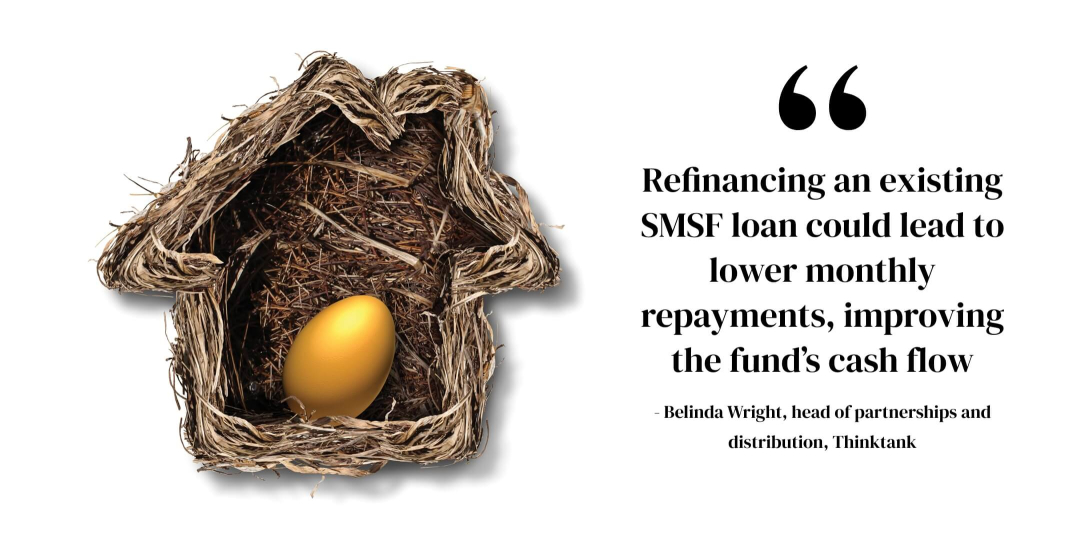A word from Thinktank
Thinktank was launched in 2006 by a group of highly experienced professionals with extensive backgrounds in property finance, business lending, consumer finance, and third-party distribution.
Established in response to the increasing demand for straightforward, set-and-forget commercial lending solutions, our product suite was extended in 2013 to include SMSF lending and later residential loan options in 2018.
Today, Thinktank stands as one of Australia’s leading non-bank property lending specialists.
When it comes to building wealth for retirement, the choose-your-own-adventure approach of a self-managed super fund (SMSF) may not be for everyone. But for an increasing number of Australians, it’s an option with plenty of upside.
The number of SMSFs reached 616,400 in March 2024 (the most recent quarterly statistical report available from the Australian Tax Office (ATO), comprising 1.1 million members and more than $932 billion in assets. That’s about 24 per cent of the $3.9 trillion currently invested in super. Compared to March 2023, these figures represent a 3.3 per cent increase in the number of SMSFs (596,370), a 2.7 per cent increase in the number of members (1.11 million) and an 8.8 per cent increase in the number of assets ($856 billion).
While listed shares continue to be the dominant asset class that Australians look to when building their SMSF, an increasing proportion of SMSF trustees are turning their thoughts to property investment.
According to the latest ATO statistics, residential property within SMSFs accounts for approximately half the value of commercial property holdings, with both asset classes making up around 14 per cent of total SMSF assets.
Commercial property represented 9.7 per cent ($91.9 billion) of the total allocation of assets. By comparison, residential property represented 5.3 per cent ($49.9 billion) of the total allocation of assets.
According to Belinda Wright, head of partnerships and distribution at Thinktank, a key driver of increasing interest in purchasing property through SMSFs is that traditional superannuation returns “may not have been meeting investment expectations” in this changing economic environment.
Wright says that the SMSF structure also offers “significant protection” for property assets, “along with compelling tax advantages during both the accumulation and pension phases of the fund”.
Given the increasing attraction to SMSF investments, Thinktank has likewise seen a notable influx of SMSF loan applications to the non-bank lender over the past 12 months for both residential and commercial purchases and refinances.
Wright says: “Interestingly, we’re seeing a more even split between commercial and residential property secured SMSF lending solutions.
“A notable feature of the split between residential and non-residential property is that it is fairly even until the size of the funds hits $1 million, and then it rapidly grows – to twice as much non-residential property for funds over $2 million and three times as much once funds exceed $5 million in size. “It will be interesting to see if future ATO data reflects a shift toward residential property relative to commercial.”
What does an SMSF borrower look like at the moment?
Thinktank’s experience is that SMSFs continue to be established by both PAYG and self-employed members, with the primary focus being their future retirement goals and preferences.
But one of the trends driving growth in commercial property investment, Wright says, is the attractive nature of SMSF limited recourse borrowing arrangements (LRBAs, where a trustee takes out the loan from a third-party lender and uses the funds to purchase an asset in a separate trust, with the returns then going to the trustee).
“We believe the growing trend of purchasing commercial properties is largely driven by SMSF LRBAs which allow an associated party – such as a member’s own business – to lease the commercial property at market rent,” Wright says.
“This arrangement makes strong financial sense, as business owners can benefit from owning their premises and building wealth, rather than paying rent. As a result, we expect the commercial property asset class within SMSFs to remain on a growth trajectory.”
However, Alexia Pettenon, finance director at Sydney-based brokerage Bid & Borrow, says cost-of-living pressures and a lack of surplus funding have also made SMSF funding an attractive option for residential property investors jostling to go up a rung on the property ladder.
“Superannuation allows them to get into the market and use those funds,” Pettenon says.
“A lot of people don’t have the opportunity to buy a second or third property in their personal name. This is a great opportunity to use those funds to get into the market.”
In the past year, there have also been several changes that present “a timely opportunity” to review an SMSF’s cash flow and explore potential refinancing options, according to Wright.
As of 1 July 2024, both concessional and non-concessional contribution limits increased (to $30,000 and $120,000, respectively), with the three-year bring-forward rule set at $360,000 for balances under $1.9 million.
Moreover, the ATO safe harbour interest rate for related party limited recourse borrowing arrangements (LRBAs) for real property has risen significantly, rising from 5.35 per cent in 2022–23 to 8.85 per cent in 2023–24, with a further increase to 9.35 per cent expected in 2024–25.
Wright says: “Many older SMSF loans were written at higher interest rates and with shorter loan terms, resulting in unnecessarily high monthly repayments.
“Refinancing an existing SMSF loan could lead to lower monthly repayments, improving the fund’s cash flow.”
However, she says that brokers need to be aware that SMSF loan refinancing must be limited to dollar-for-dollar transactions, with no cashout or equity release allowed by law.

Digging into the detail
Unlike other forms of lending finance, though, superannuation remains a highly regulated industry, with ever-evolving legal requirements.
Brokers who write SMSF loans must ensure they are never offering financial, legal, or tax advice and seek assurance that they’re writing loans appropriately. SMSF loans must adhere to the SIS Act and brokers must ensure the loan is used for acquiring a single asset in accordance with the SMSF’s investment strategy and the structure must be correct, typically involving a bare trust to hold the asset.
“Ensuring all steps align with SMSF regulations is essential to avoid penalties and complications and, in this regard, clients should equip themselves with quality professional advice,” Wright says.
“Proper guidance on contribution caps and tax regulations is also crucial to ensure clients remain compliant while maximising the benefits of their SMSF investment.
“While an SMSF structure can provide superior protection of assets and offer attractive taxation benefits in retirement, the borrowing capacity of a fund can be limited depending upon the number of members and contribution limits."
New legislation being debated in government may also see changes to SMSF borrowings. At the time of writing, the federal government was debating the introduction of a Treasury Laws Amendment (Better Targeted Superannuation Concessions and Other Measures) Bill 2023 that would lead to an increase in the super tax on certain funds.
The bill proposes that those with more than $3 million in super balances should be taxed at a rate greater than 30 per cent, compared to the current rate of 15 per cent, with unrealised gains forming part of that.
“If passed, this tax will likely take effect in 2025–26 and could have implications on how SMSFs are used in the future which the industry is continuing to monitor closely,” Wright says.
However, this shouldn’t be seen as a reason to ignore opportunities in this space. Wright says SMSF lending shouldn’t be seen as something too complex, risky, or expensive.
A lender specialising in LRBAs, such as Thinktank, is well versed in helping brokers navigate the space.
“We definitely encourage brokers looking to expand their expertise or refresh their knowledge to connect with our dedicated Thinktank Relationship Manager team,” Wright says.
“Our team offers invaluable support at every stage – from initial workshops through to settlement – and is always available for informal discussions, sharing the latest industry insights and updates.”
Opportunity to grow
Wright believes that the market for SMSF transactions will only “continue to grow into the future”
Pettenon agrees and encourages brokers who wish to write this class of finance to keep an open mind, understand the rules and regulations, and stay up to date with lender policies.
“It’s sticky business. And it’s just a good offering to have,” Pettenon says.
“Sometimes when people are tapped out on the personal side, you can say, ‘Have you looked at SMSF lending?’ A lot of people haven’t, and they get excited by the opportunity.”
All this is good news for brokers who provide access to the finance funding these investments. Brokers who can work in this space add an extra string to their bow, helping clients navigate the complexity of and realise the opportunity in SMSF lending.




